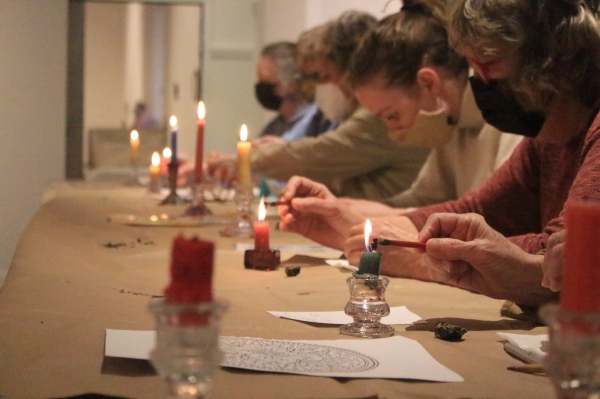BRATTLEBORO — With eggs from her own hens and wax from her own hive, Jenny Santa Maria offered a hands-on introduction to the art of pysanky - Ukrainian egg decorating - workshop on April 9.
Using a tool called a kitska, Santa Maria scoops a small amount of beeswax and heats it over a candle flame. She then uses the kitska to draw with the wax on the egg before dipping it into different colors of dyes.
With multiple applications of the wax and the dyes, you won't know the outcome of this wax-resist batik process until the egg is finished.
“My favorite part about doing this work is the big reveal,” Santa Maria says.
A rich legacy
The workshop also included some of the history of pysanky as well as the traditional meanings of different symbols, colors, and animals.
Santa Maria explains that the same technique that she uses and teaches goes back thousands of years - that ”the whole idea was not just to make beautiful things, but to celebrate that hardship might be over.”
Pysanky is traditionally very communal, and Santa Maria tries to create that environment in her workshops.
With the eggs traditionally made by multiple generations of women in a family, Santa Maria learned the art form from a woman she used to babysit for - someone who didn't have daughters to pass the tradition down to.
“Little did I know that she changed my life the way she did, because she passed something on to me,” says Santa Maria. “It's not in my culture - it's very unusual.”
She explains that the usual way one learns how to do the art comes from one's church or from one's family.
“There's such a need for someone like me to teach this because there are so many people that don't have their parents or grandparents around,” Santa Maria says.
Egg decorating skills have been lost in families separated by war or other circumstances. “There are all kinds of reasons that people miss that part [of their culture],” Santa Maria says.
And so the artist, based on the Jersey Shore, offers these workshops up and down the East Coast. They attract participants with a variety of experience who want to learn pysanky.
'Beaming with delight'
In the workshops, anywhere from a quarter to a half of a student group will be of Ukrainian Polish descent, Santa Maria says.
And, of course, looming over a pysanky workshop in 2022 is the war in Ukraine, and for participants who have a connection to the Eastern European region, the experience was especially meaningful.
“Especially during all these horrible times with the crisis, I thought [taking the workshop] would be really one wonderful thing to do to honor Ukrainian culture and keep it alive and learn something new,” says Annalisa Bischoff. “I think that's so important.”
“My grandmother's from Hungary very near the border of Ukraine,” Bischoff says. “And I'm also just beaming with delight that I'm here.”
Another participant, Nicole Tretiak, took the class to get “a basic understanding of what the art really is.” She said she didn't just learn how to paint an egg, but she learned the technique, its traditions, and its history.
A healing art in an era of war
“You know, I really think that this is going to be my life's work,” says Santa Maria, who on her website emphasizes that in her own egg artwork, she uses the same techniques of pysanky but prefers the term “batik eggs” because “I don't use religious imagery and I don't participate in the cultural traditions and prayers associated with pysanky.”
And the artist, who on her website describes the lost-wax process as “therapeutic and meditative,” asks: “Given our very technology driven, fast-paced time that we live in - a time of war - the question is, 'How are we going to heal ourselves?'”
Santa Maria wants people to know that “to practice an art that represents hope and beauty is something that anybody can do.”
